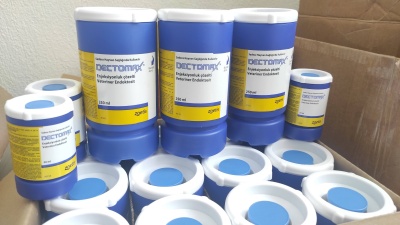TR - methionine injection
tonarsil
Tonarsil Injectable Solution Veterinary Vitamin – Mineral Used Only in Animal Health
COMPOSITION: Each ml of red, clear, sterile solution;
Contains acetyl methionine 20 mg Cyanocobalamin 100 mcg Ferric-ammonium sulfate 5 mg Vitamin B1 10 mg Vitamin B6 10 mg Niacinamide 40 mg Calcium pantothenate 15 mg Biotin 10 mcg Copper gluconate 0.02 mg Sodium selenite 0.33 mg.
Tonarsil PHARMACOLOGICAL PROPERTIES
Methionine is an essential amino acid in the protection of liver cells and the synthesis of choline and creatine. It also takes part in milk synthesis. It has a role in the synthesis of phospholipids, which are important in the functioning of the nervous system and in the protection of blood cell tissue. Once absorbed, methionine is converted to S-adenosyl methionine, which acts as a methyl donor. Methionine compounds metabolized in the liver are excreted in the urine.
Vitamin B1 basically functions in the functioning of the Krebs cycle by participating in the synthesis of fatty acids originating from acetyl coenzyme A. Vitamin B1 deficiency or failure to meet the increased need causes disruption in glycolysis; Therefore, it causes accumulation of pyruvic acid in the blood. At the same time, since fatty acid synthesis, which is essential for the activity of neurons, will be disrupted, serious muscular and neural disorders occur. Vitamin B1 functions as a coenzyme of many enzyme systems that play an important role in the metabolism of sugars. These enzymes enable the decarboxylation of alpha-keto acids such as pyruvic acid and alphaketoglutaric acid and the use of pentose in the hexose monophosphate pathway.
Vitamin B6 works as a coenzyme of many enzymes in amino acid, fatty acid and carbohydrate metabolism. The increase in protein substances in the feed causes the need for Vitamin B6 in the organism to increase. After vitamin B6 is absorbed, it is converted into pyridoxal and used in the formation of auxiliary enzymes. 4-pyridoxyl acid, the most important excretion product of all three forms, is formed in the liver by the action of aldehyde oxidase on free pyridoxal and is excreted in the urine.
Vitamin B12 is necessary for the development, proliferation and functioning of the cells involved in the production of red blood cells in the bone marrow. Its function here is to ensure the assimilation of proteins and their synthesis from amino acids.
Biotin works as a coenzyme of some enzymes involved in amino acid metabolism. Deficiency causes disorders in the skin and skeletal system, and problems with fatty liver and kidneys. It is effective in the development of the structure of epidermic tissues, normal development of bone tissue and reproductive potential.
Niacin (Vitamin PP) plays a role in the formation of coenzymes (NAD and NADP) that are critical in energy metabolism and in the protection of blood vessels. Niacin is well absorbed from parenteral application sites. It is distributed to all body tissues and is excreted unchanged in the urine in small amounts when given in therapeutic doses.
Calcium pantothenate enters the structure of coenzyme A and participates in the synthesis of fatty acids, cholesterol, steroid hormones, bile acids, acetylcholine and many mucopolysaccharides. It is important in the formation of connective tissue, cartilage and skeletal elements. Pantothenic acid also plays a role in preventing fatty degeneration in the liver in poultry. Absorbed pantothenic acid is distributed throughout the body and approximately 70% is excreted unchanged in the urine. B group vitamins are mostly stored in the liver and spleen.
Copper is a compound that plays a role as a coenzyme or activator in many enzymatic activities of the organism. Its activation in energy and protein metabolism is important in the formation of hemoglobin, keratin, melanin, cerebroside, myelin and proteinic bone matrices. Circulating copper is retained by the liver and mixed with some tissue proteins. Most of the copper found in plasma is in the form of an alpha-globulin oxidase known as ceruloplasmin.
Iron is the central element of the hemoglobin molecule. It is especially beneficial for lactose-based and iron-deficient diets seen in young animals.
Selenium is found in the structure of the glutathione peroxidase enzyme, which has a protective function in the cell structure and membranes. In case of selenium deficiency, this protection disappears and muscle fibers begin to lose their functions due to the effect of amyloidosis. Selenium largely leaves the body through urine.
AREA OF USE
Tonarsil is used in horses, cattle, sheep, goats and dogs;
It is used to support metabolism in digestive disorders, nervous and skeletal system disorders, in convalescent periods of diseases, in signs of malnutrition and developmental delays, in fatty liver, liver failure and intoxications as a supplement to the main treatment, in vitamin and mineral deficiencies and related disorders.
USAGE AND DOSAGE
Tonarsil is used by intramuscular or intravenous injection. Practically, 1-2 ml is given per 40 kg live weight. The application continues for 4-5 days.








